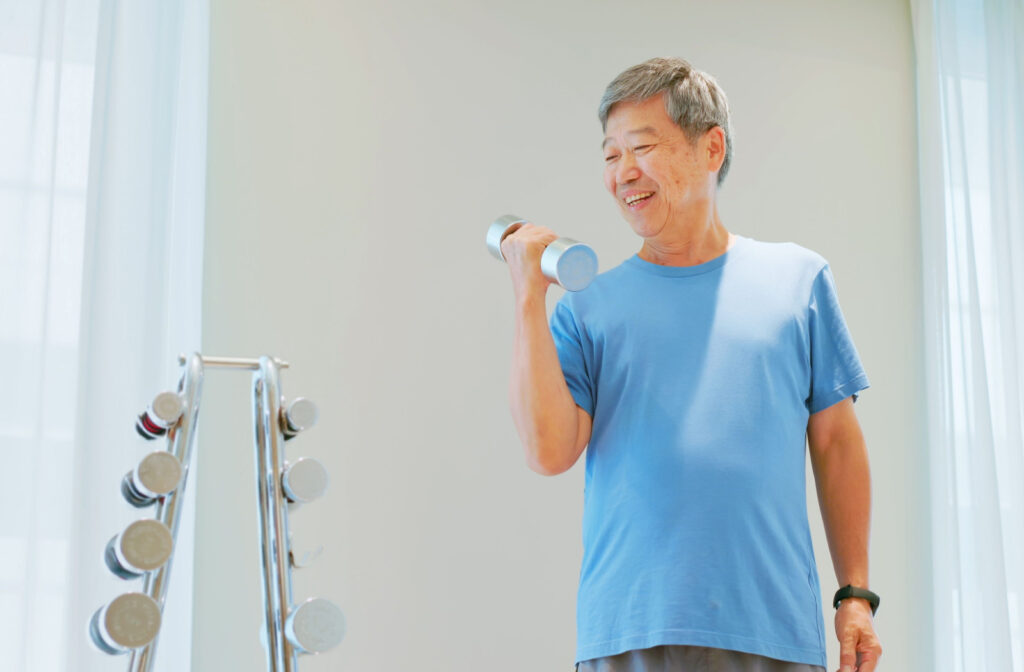Aging doesn’t mean waving goodbye to a fit and muscular body. If you’re over 60, it’s more crucial than ever to maintain an active lifestyle. Regular exercise and strength training can not only help you maintain your overall health but also empower a more vibrant, independent life.
Here some some exercises and tips for maintaining a healthy, active life:
- Set realistic goals
- Consult your doctor
- Incorporate resistance training
- Watch your diet
- Listen to your body
- Incorporate cardio
- Stay hydrated
- Work on your flexibility
- Be consistent
Muscle-Building Tips & Exercises
Even if you aren’t particularly muscular, it’s not impossible to build muscle after 60! But, you are a bit older now, so it’s important to take it slowly and, with the right approach, you can maintain your strength and mobility.
Set Realistic Goals
It’s essential to set realistic and achievable goals for building muscle over 60. Realistic goals will help you maintain motivation, track progress, and avoid injuries. The body takes longer to build muscle as we age, so patience is key. Start with smaller, more manageable goals, like improving your overall strength, increasing muscle mass in specific areas, or being able to complete a certain number of repetitions or sets.
Consult Your Doctor
Before starting any new exercise program, it’s always a good idea to consult your doctor first. This step is crucial if you have pre-existing health conditions or injuries. Your doctor can provide valuable insights on what exercises are best for your body and any modifications you may need to make.
Incorporate Resistance Training
Resistance training, or strength training, is essential for building muscle at any age. It helps strengthen bones, improve balance and coordination, and increase muscle mass.
When starting a resistance training program over 60, it’s important to start slow and gradually increase intensity over time. Resistance can be added through bodyweight exercises or with equipment like dumbbells or resistance bands.
Watch Your Diet
Building muscle requires proper nutrition. As we age, our metabolism tends to slow down, making it easier to gain weight. It’s crucial to maintain a balanced diet with enough protein to support muscle growth. Aim for 1 to 1.2 grams of protein per kilogram of body weight daily and incorporate whole foods like lean meats, fish, beans, and nuts.
Listen to Your Body
As we grow older, our bodies aren’t always able to cope with the same level of intensity as we did in our youth. Pay attention to any discomfort or pain and adjust your workouts accordingly. Don’t push yourself too hard and always listen to your body’s limits. If you experience any concerning symptoms, such as chest pain or shortness of breath, stop exercising immediately and call your doctor.
Incorporate Cardio
While resistance training is vital for muscle building, it’s equally important to integrate cardiovascular exercises into your fitness regimen. Cardio helps improve heart health, increase endurance, and support weight management. Aim for at least 30 minutes of moderate aerobic activity (like walking or swimming) 5 days a week.
If you have a pre-existing health condition, consult your doctor before starting a new cardio routine.
Stay Hydrated
Proper hydration is essential for people of all ages but is increasingly especially important for those over 60. Our bodies become less efficient at retaining water as we age, increasing our risk of dehydration. Dehydration can lead to fatigue, dizziness, and other health complications.
Make sure to drink plenty of water before, during, and after your workouts. As much as possible, incorporate foods high in water, such as fruits and vegetables, into your meals.
Don’t Forget About Flexibility
Many people focus solely on strength and cardio training for fitness, but flexibility is just as important because it can help prevent injuries and improve mobility. Our muscles can become stiff with age, making everyday tasks more difficult. Incorporating stretching and flexibility exercises into your routine with yoga, tai chi, or other exercises, can help maintain flexibility and range of motion.
Be Consistent
Consistency is key for fitness, especially for older bodies that may take longer to adapt and see results. It’s important to maintain a regular workout schedule to reap the benefits of exercise.
Consistency also helps prevent injuries as your body becomes accustomed to the movements and exercises.
Aim for at least 3 days of strength training and 2 days of cardio per week. And remember, any physical activity is better than none at all!

Live Your Best Life at Meadowcrest at Middletown
Building muscle can be challenging when we reach 60, but it’s never too late to start. At Meadowcrest at Middletown, we encourage and support healthy, active living so we offer a variety of fitness activities specifically tailored to you.
We invite you to visit us and learn how our retirement community can help you achieve your fitness goals and continue living your best life!





